The James Webb Space Telescope can generate 57GB of data per day, compared to the Hubble Telescope which generates about 1-2GB daily. But the Webb is too far away for any sort of maintenance mission so the tech needs to work perfectly.
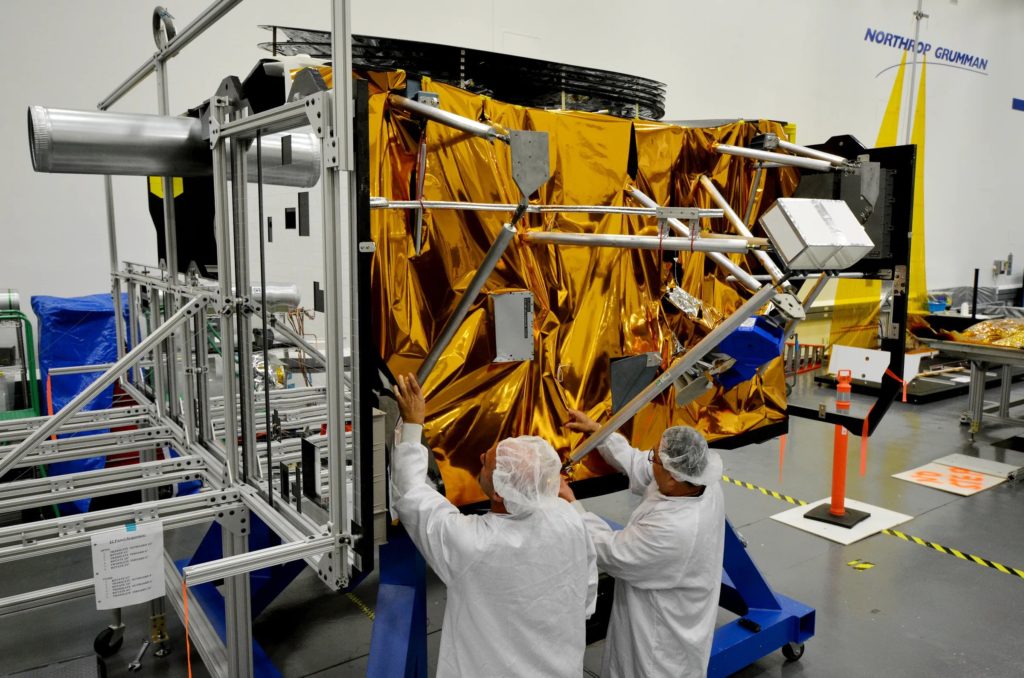
Technicians at Northrop Grumman Aerospace Systems facilities in Redondo Beach, California work on a mockup of the James Webb Space Telescope (JWST) spacecraft bus—home of the observatory’s power, flight, data, and communications systems (photo courtesy of NASA JWST web page)
18 July 2022 – A few years ago I wrote a piece saluting Apollo 11 on the 50 year anniversary of the Apollo moon landing. And my favorite podcaster Charles Christian interviewed me as a follow-up.
As I noted, I think 3 years ago we were all desperate, looking to celebrate a grand common project – something more heroic and uplifting than calling people out on Facebook or Twitter. Apollo was a dream of “past glory” because we hate the present, seeing ourselves spiraling forever downward to a destiny foretold. The Apollo space program was the capstone of an era in which Americans took it for granted that the federal government could and should solve big challenges. It was one of America’s defining moments. Engineering, heros and awe – all in one package.
But not since then has the U.S. tried something as ambitious or as expensive. Yes, Americans still take risks and solve problems, but they don’t look to the federal government to do it. Back then, the federal government, enmeshed in the space race and Cold War, spent twice as much as private business on R&D. Today, business spends three times as much as the federal government. We now equate risk-taking and innovation not with moonshots, but with venture capitalists, pharmaceutical labs and internet entrepreneurs.
Yes, Presidents still invoke the spirit of Apollo. Obama had called for an Apollo-scale investment in renewable energy and a “moonshot” to cure cancer; even Trump had said he wanted to return to the moon, and then go to Mars.
But on that 50th anniversary three years ago, Greg Ip (Science editor for the Wall Street Journal) noted on his blog:
These grand visions lack Apollo’s unifying motivation of the Cold War, the clarity of its target, and the New Deal faith in big, ambitious government. The intensifying U.S. rivalry with China is sometimes called a new Cold War, but it’s being waged with private investment such as in 5G telecom networks, not public projects.
Yep. We can solve ‘X’ – provided it is a technical challenge. But you need to throw money at it and manage how it is spent properly. But today more of our problems are social – and you can’t solve social problems that way.
The JWST takes us back (sort of) to those glory days. It’s story is both awe-inspiring and mind-numbing. Last year I laid out the amazing technical challenges of the JWST and the groundbreaking engineering required to make it work. For a summary of the Webb mission click here.
We have already benefited earthbound life because some of that groundbreaking engineering has made far more precise medical procedures possible. And JWST is the culmination of a 20-year project. Sometimes, humans are pretty good at things. Maybe the JWST is a cause for optimism in itself.
On a personal note, the adventure continues. It started as a kid growing up in New York City with frequent trips to the Hayden Planetarium and the delight of trips to an aunt and uncle who lived in Florida near Cape Canaveral, site of the NASA launch complex. My uncle worked there and often got me into the facilities. It was a wonder. I watched many a launch, live, and got to meet space scientists and engineers and even a few astronauts-in-training.
I became fascinated by astronomy, going through a series of telescopes and making multiple visits to planetariums and observatories around the U.S., and eventually across Europe. It resulted in my completing a minor in physics at university.
The passion continued. I followed with delight the European Space Agency launch of Rosetta, with Philae, its lander module, and its subsequent landing on a comet 10 years later. ROSETTA! IMAGINE! A space vehicle launched in March 2004 … with technology on board that had been developed in 1999 and 2000 (space technology usually takes 4-5 years of testing until proven before put on board a spacecraft). It then landed, as planned, 10 years later – with 92% of its technology working.
My fascination continues to this day. In one of my visits to CERN in Geneva (home to the Large Hadron Collider), I attended sessions to learn how to write computer code to track planets and stars … and to learn the basics of observatory science. Every year at the world’s largest industrial fair, the Hannover Messe, CERN and the European Space Agency always present wondrous technologies they have developed, many that could find applications in space.
And almost every night I look up and can see this:
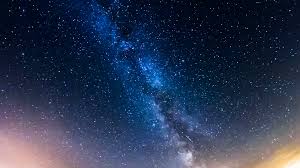
Night sky over my house in Greece, shot by photographer friend Panos Euripiotis
My Greek island is what you would expect the topography of the earth to look like if it was given a fair chance. It is not mysterious or impenetrable, but it is awesome – made of earth, air, fire and water. It changes seasonally with harmonious undulating rhythms. It breathes. Here you can get a bit nearer to the stars and the ether. It is where I came as a child (and now as an adult) to feel the earth, feel space.
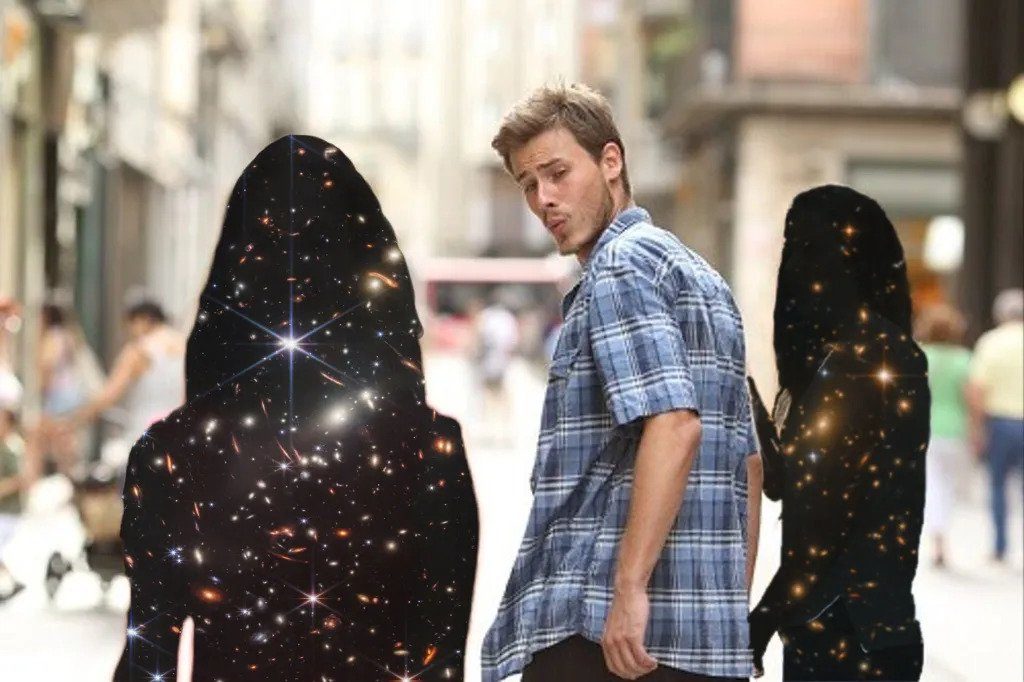
But as for space and technology, the Webb Telescope is a cut above the rest.
The first set of images it revealed last week were the by-product of carefully crafted mirrors and scientific instruments. But all of its data-collecting prowess would be moot without the spacecraft’s communications subsystem. And the Webb’s communications are not flashy. Rather, the data and communication systems are designed to be incredibly, unquestionably dependable and reliable. And while some aspects of them are relatively new – it’s the first mission to use Ka-band frequencies for such high data rates so far from Earth, for example – above all else, the communications provide the foundation upon which JWST’s scientific endeavors sit.
JWST is parked at Lagrange point L2. Simply put: it’s a point of gravitational equilibrium located about 1.5 million kilometers beyond Earth on a straight line between the planet and the sun. It’s an ideal location for JWST to observe the universe without obstruction and with minimal orbital adjustments.
Being so far away from Earth, however, means that data has farther to travel to make it back in one piece. It also means the communications subsystem needs to be reliable, because the prospect of a repair mission being sent to address a problem is, for the near term at least, highly unlikely. Given the cost and time involved, says Michael Menzel, the mission systems engineer for JWST, “I would not encourage a rendezvous and servicing mission unless something went wildly wrong”. According to Menzel, who has worked on JWST in some capacity for over 20 years, the plan has always been to use well-understood Ka-band frequencies for the bulky transmissions of scientific data. Specifically, JWST is transmitting data back to Earth on a 25.9-gigahertz channel at up to 28 megabits per second. The Ka-band is a portion of the broader K-band (another portion, the Ku-band, was also considered).
Both the data-collection and transmission rates of JWST dwarf those of the older Hubble Space Telescope. Compared to Hubble, which is still active and generates 1 to 2 gigabytes of data daily, JWST can produce up to 57 GB each day (although that amount is dependent on what observations are scheduled). Menzel says he first saw the frequency selection proposals for JWST around 2000, and he knew the time required to get this fully developed.
And to satisfy the tech nerds amongst you who follow my space newsletter, two points:
•Besides, Ka-band frequencies can transmit more data than X-band (7 to 11.2 GHz) or S-band (2 to 4 GHz), common choices for craft in deep space. A high data rate is a necessity for the scientific work JWST will be undertaking. In addition, according to NASA briefing last week, a comparable X-band antenna would be so large that the spacecraft would have trouble remaining steady for imaging.
•And although the 25.9-GHz Ka-band frequency is the telescope’s workhorse communication channel, it also employs two channels in the S-band. One is the 2.09-GHz uplink that ferries future transmission and scientific observation schedules to the telescope at 16 kilobits per second. The other is the 2.27-GHz, 40-kb/s downlink over which the telescope transmits engineering data—including its operational status, systems health, and other information concerning the telescope’s day-to-day activities.
Any scientific data the JWST collects during its lifetime will need to be stored on board, because the spacecraft doesn’t maintain round-the-clock contact with Earth. Data gathered from its scientific instruments, once collected, is stored within the spacecraft’s 68-GB solid-state drive (3 percent is reserved for engineering and telemetry data). In another NASA briefing it was noted that by the end of JWST’s 10-year mission life, they expect to be down to about 60 GB because of deep-space radiation and wear and tear. The onboard storage is enough to collect data for about 24 hours before it runs out of room. Well before that becomes an issue, JWST will have scheduled opportunities to beam that invaluable data to Earth.
JWST will stay connected via the Deep Space Network (DSN) – a resource it shares with the Parker Solar Probe, Transiting Exoplanet Survey Satellite, the Voyager probes, and the entire ensemble of Mars rovers and orbiters, to name just a few of the other heavyweights. The DSN consists of three antenna complexes: Canberra, Australia; Madrid, Spain; and Barstow, Calif. JWST needs to share finite antenna time with plenty of other deep-space missions, each with unique communications needs and schedules.
And perhaps of interest to my cybersecurity, eDiscovery and media readers, all of the communications channels use the Reed-Solomonerror-correction protocol – the same error-correction standard as used in DVDs and Blu-ray discs as well as QR codes. The lower data-rate S-band channels use binary phase-shift key modulation – involving phase shifting of a signal’s carrier wave. The K-band channel, however, uses a quadrature phase-shift key modulation. Quadrature phase-shift keying can double a channel’s data rate, at the cost of more complicated transmitters and receivers. Also, JWST’s communications with Earth incorporate an acknowledgement protocol – only after the JWST gets confirmation that a file has been successfully received will it go ahead and delete its copy of the data to clear up space.
Fun note: the communications subsystem was assembled along with the rest of the spacecraft bus by Northrop Grumman, using off-the-shelf components sourced from multiple manufacturers.
JWST has had a long and often-delayed development, but its communications system has always been a bedrock for the rest of the project. Keeping at least one system dependable means it’s one less thing to worry about. And communications was, obviously, a critical system.
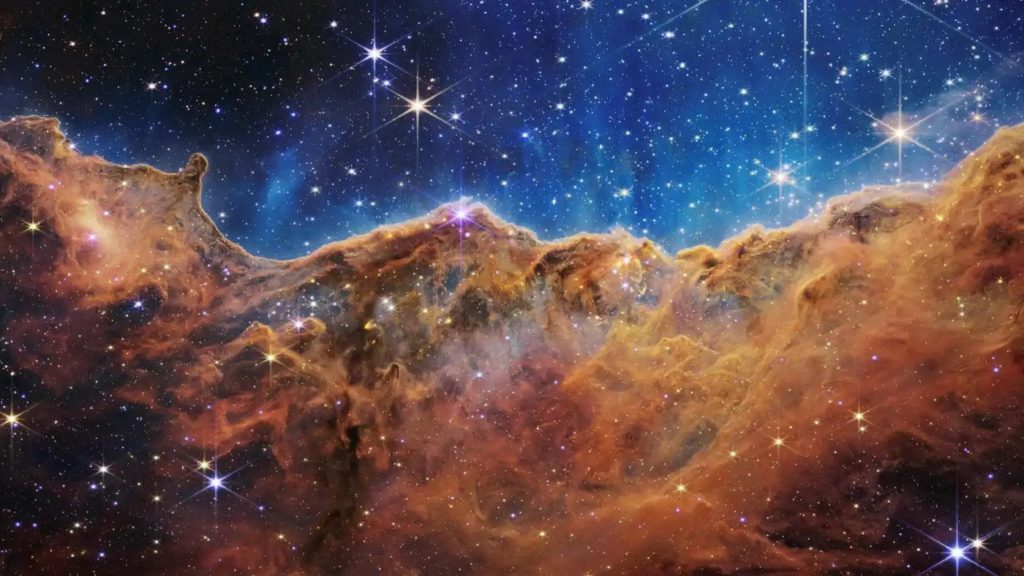
NASA orients its images with “horizons” at the top, and portrays deep space gases vibrantly
And a few notes on the images. The first batch produced some jaw-dropping results, multicoloured images of stars dying and galaxies circling each other. The pictures are undeniably impressive, but what exactly are they?
Not photographs, since a conventional camera would fail to detect much in the darkness, dust and gas of deep space. The infrared light captured by the telescope was translated into colors by scientists at the NASA space agency to make them more accessible and appealing. Some space pictures require “a little extra work here or there, just to get that thing to pop a little more”, one astronomer said. Many of us know the feeling: I often adjust my iPhone photos to make them bolder, or turn them “vivid warm”. It can be done with the phone’s software by touching the screen.
The old days of taking one’s chances with a roll of film and a camera shutter are over. Phones have replaced cameras, those of the latter still being sold are almost all digital, and Nikkei reported last week that Nikon is to phase out single lens reflex cameras. Nikon first launched an SLR in 1959, but even professional photographers are switching to mirrorless cameras. Farewell to gazing directly through a camera lens before the clunk of the mirror lifting and the shutter releasing.
The Webb telescope has mirrors – one 6.5-metre reflector panel gathers light from space and deflects it via a second mirror on to four sensors – but such intricacy is redundant on Earth. NASA is well aware of the need for inspiring images. It takes a lot of money to put rockets and astronauts into space, and the agency will only remain funded with public support for its missions. Planting a telescope 1.5mn km from Earth and receiving back data that only makes sense to astronomers would not generate excitement.
And in reality, these would actually have been visible at some point but are so far away they’ve been redshifted by the expansion of the universe.
It was simpler in the era of Moon landings, when humans could be pictured taking giant leaps for mankind. That was when photos such as “Earthrise”, taken from Apollo 8 in lunar orbit in 1968, electrified the world:
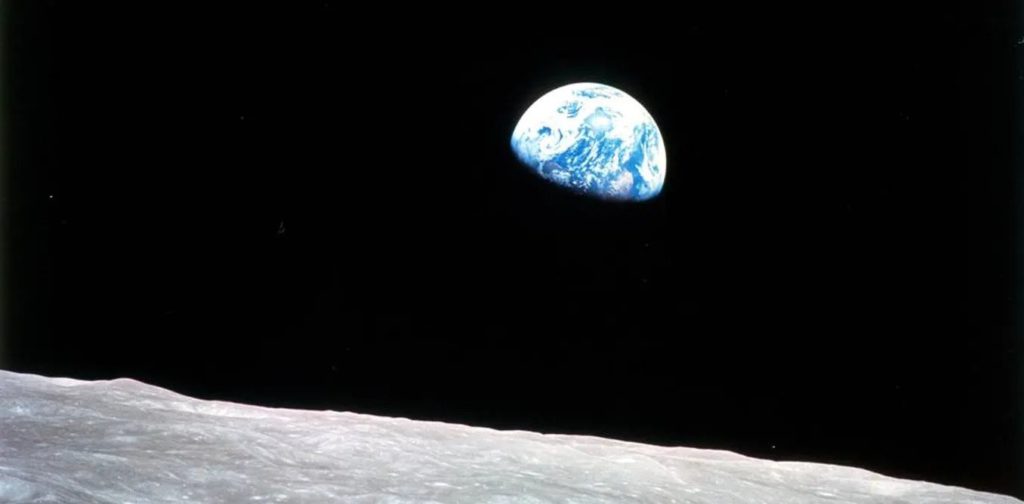
The Webb telescope is harder to dramatise, since it mostly captures radiation from outside the visible spectrum — the Hubble space telescope, its predecessor, primarily observes visible light. It takes NASA’s version of Photoshopping to create the impressive colour images from what the instruments collect. So it’s CGI but representative of what’s there but invisible.
And NASA is pretty upfront about it. Last week they used the word “dataset” rather than “picture” during the image briefing, referencing the data files of pixels received from Webb.
In this light, converting the Web datasets into pictures would seem to be similar to creating charts to view data.
NASA employs “chromatic ordering”, using blues to represent short-range infrared light, and greens and reds for longer ranges. This produces real images of stars light years away, but it is coloring by numbers. Some of the American ingenuity in space exploration goes into making good slideshows. The majestic compositions and dramatic lighting in the Hubble telescope images of space have been compared to landscapes of the American West by 19th-century painters and photographers. The agency knows how to evoke the pioneering spirit.
More fool us: even knowing how it is done, I find the result entrancing. We know the pictures are not real, that they are paintings by NASA artists, but it does not stop us from attributing meaning to them. Perhaps we indulge NASA because of the sneaking feeling that we are up to similar tricks ourselves. It orients its images with “horizons” at the top, and portrays deep space gases vibrantly; we take multiple photos to ensure everyone is smiling with their eyes open, and make the faces more luminous.
But ask any of your photography buffs and they will tell you film cameras with mirrors are no more inherently faithful in reflecting reality than those with sensors. The phrase “the camera never lies” was always meant ironically, and most underexposed prints were botched by the photographer rather than being intentionally dark. But the ease with which digital images can be amended or enhanced makes artifice spread. Photo editing software used to be expensive and fiddly, but filters and tints now come built in. It takes restraint not to make every landscape shot dramatic and moody – like Nasa’s image of deep spaces, in fact.
Thus does the sublime become mundane. This is not entirely Nasa’s fault: it had to transform its Webb telescope data into colors, given that there would otherwise have been nothing to see. The American public would have been terribly disappointed not to get a visual return on their investment.
The difficulty is not that Nasa can do it, but that so many others can, too. When every image of vehicles at night on a motorway, or a misty valley at sunrise, is algorithmically awe-inspiring, deep space has got competition. We gaze into galaxies for meaning and find a snapshot instead.